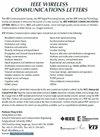Ghost Convolutional Neural Network-Based Lightweight Semantic Communications for Wireless Image Classification
IF 5.5
3区 计算机科学
Q1 COMPUTER SCIENCE, INFORMATION SYSTEMS
引用次数: 0
Abstract
Most convolutional neural network (CNN)-based lightweight semantic communication (SemCom) schemes mainly focus on reducing the number of regular convolutional modules to reduce the semantic encoder (SemEnc) complexity. However, this approach has limited ability to reduce the SemEnc complexity and weakens the representational capacity. To solve these issues, this letter proposes a ghost CNN (GCNN)-based lightweight SemCom scheme for wireless image classification. Specifically, we adopt the ghost convolutional (GC) module to extract semantic features, which reduces the SemEnc complexity and enhances the representational capacity. To prevent the gradient vanishing and improve the convergence speed, we utilize ghost bottleneck (G-bneck) blocks to stack GC modules. By cascading multiple G-bneck blocks, a lightweight SemEnc is constructed. Moreover, to enhance the robustness of the proposed GCNN against stochastic wireless channels, we design a spectral-spatial attention module that adaptively scales semantic features based on channel state information. Experimental results show that the proposed GCNN achieves the best classification accuracy and reduces the number of parameters and floating-point operations by factors of 2 and 8, respectively, compared with the state-of-the-art scheme.基于鬼卷积神经网络的无线图像分类轻量级语义通信
大多数基于卷积神经网络(CNN)的轻量级语义通信(SemCom)方案主要侧重于减少规则卷积模块的数量,以降低语义编码器(SemEnc)的复杂度。然而,这种方法降低语义复杂性的能力有限,并且削弱了表示能力。为了解决这些问题,本文提出了一种基于鬼CNN (GCNN)的轻量级SemCom无线图像分类方案。具体来说,我们采用鬼卷积(GC)模块提取语义特征,降低了语义复杂度,增强了表征能力。为了防止梯度消失和提高收敛速度,我们利用幽灵瓶颈(G-bneck)块来堆叠GC模块。通过级联多个g颈块,构建了一个轻量级SemEnc。此外,为了增强GCNN对随机无线信道的鲁棒性,我们设计了一个基于信道状态信息自适应缩放语义特征的频谱空间注意模块。实验结果表明,与现有方案相比,本文提出的GCNN分类精度最高,参数个数和浮点运算次数分别减少2倍和8倍。
本文章由计算机程序翻译,如有差异,请以英文原文为准。
求助全文
约1分钟内获得全文
求助全文
来源期刊

IEEE Wireless Communications Letters
Engineering-Electrical and Electronic Engineering
CiteScore
12.30
自引率
6.30%
发文量
481
期刊介绍:
IEEE Wireless Communications Letters publishes short papers in a rapid publication cycle on advances in the state-of-the-art of wireless communications. Both theoretical contributions (including new techniques, concepts, and analyses) and practical contributions (including system experiments and prototypes, and new applications) are encouraged. This journal focuses on the physical layer and the link layer of wireless communication systems.
 求助内容:
求助内容: 应助结果提醒方式:
应助结果提醒方式:


